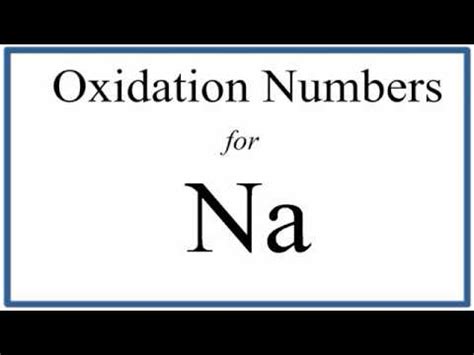What Is The Oxidation Number For Sodium
News Leon
Apr 01, 2025 · 4 min read

Table of Contents
What is the Oxidation Number for Sodium? A Deep Dive into Oxidation States
Understanding oxidation numbers is crucial for mastering chemistry, particularly in balancing redox reactions and predicting the reactivity of elements and compounds. This comprehensive guide will delve into the oxidation number of sodium, exploring its consistent value, the underlying principles determining it, and its implications in various chemical contexts. We'll also touch upon exceptions (though rare for sodium!), and provide practical examples to solidify your understanding.
The Invariable Oxidation State of Sodium: +1
The oxidation number, or oxidation state, of sodium (Na) is always +1. This unwavering value stems from sodium's electronic configuration and its position in the periodic table. Let's break down why:
Sodium's Electronic Structure and Reactivity
Sodium is an alkali metal, residing in Group 1 (or IA) of the periodic table. This group is characterized by elements possessing one electron in their outermost (valence) shell. Sodium's electronic configuration is 1s²2s²2p⁶3s¹. This single valence electron is relatively loosely held, making sodium highly reactive.
Achieving Octet Stability: The Key to Oxidation State
Atoms strive to achieve a stable electron configuration, often resembling the noble gases (Group 18). This stable configuration, typically characterized by a full outermost shell (octet rule), is achieved through gaining, losing, or sharing electrons. Sodium readily loses its single valence electron to achieve the stable electron configuration of neon (1s²2s²2p⁶).
Ionization and Oxidation Number
Losing this electron transforms sodium into a positively charged ion, Na⁺. This loss of an electron equates to an oxidation process. The oxidation number represents the charge an atom would have if all bonds were completely ionic. Since sodium loses one electron to become Na⁺, its oxidation number is +1.
Why Doesn't Sodium Exhibit Other Oxidation States?
Unlike transition metals, which can exhibit multiple oxidation states due to their ability to lose electrons from multiple shells, sodium's consistent +1 oxidation state is attributable to its electronic structure. It only has one electron in its valence shell readily available for donation. Forcing sodium to lose more electrons would require overcoming significantly higher ionization energies, making such a process highly unfavorable under typical chemical conditions.
The High Ionization Energies of Sodium
The energy required to remove an electron from an atom is known as ionization energy. The first ionization energy of sodium (removing the 3s electron) is relatively low, explaining its ease of oxidation. However, the subsequent ionization energies to remove electrons from inner shells are significantly higher, making it energetically improbable for sodium to exhibit oxidation states beyond +1.
Sodium in Chemical Compounds: Examples and Applications
Sodium's consistent +1 oxidation state simplifies predicting the formulas and properties of its compounds. Let's consider some examples:
Sodium Chloride (NaCl): Table Salt
In sodium chloride, sodium loses one electron to chlorine (which gains one electron to achieve a stable octet). This results in the formation of Na⁺ and Cl⁻ ions, held together by electrostatic attraction in a crystal lattice. The oxidation number of sodium remains +1, and the oxidation number of chlorine is -1.
Sodium Oxide (Na₂O)
Similarly, in sodium oxide, two sodium atoms each lose one electron to an oxygen atom (which gains two electrons to achieve a stable octet). This results in two Na⁺ ions and one O²⁻ ion. Again, the oxidation number of sodium is consistently +1.
Sodium Hydroxide (NaOH): A Strong Base
Sodium hydroxide is a strong base, widely used in various industrial applications. The sodium ion (Na⁺) carries a +1 oxidation state, while the hydroxide ion (OH⁻) carries a -1 charge.
Sodium Carbonate (Na₂CO₃): A Versatile Compound
Sodium carbonate (washing soda) is another widely used compound with sodium consistently in the +1 oxidation state.
Rare and Extreme Conditions: Hypothetical Scenarios
While highly improbable under typical chemical conditions, extremely high-energy environments might theoretically force sodium to exhibit higher oxidation states. However, these scenarios are largely hypothetical and not observed under normal laboratory settings. Such conditions might involve interactions with highly reactive species in extreme environments such as stellar atmospheres. But, for all practical purposes in typical chemical reactions, the oxidation number of sodium is considered a constant +1.
Practical Applications of Understanding Sodium's Oxidation State
Knowing the unwavering +1 oxidation state of sodium greatly simplifies chemical calculations and predictions:
- Balancing Redox Reactions: Easily determine the number of electrons transferred in redox reactions involving sodium.
- Predicting Formulae of Compounds: Quickly deduce the chemical formula of sodium compounds based on the oxidation states of other elements involved.
- Analyzing Chemical Reactions: Understand the changes occurring during chemical reactions involving sodium.
Conclusion: Sodium's Consistent Oxidation State of +1
In conclusion, the oxidation number of sodium is invariably +1. This consistent value is a direct consequence of sodium's electronic structure and its strong tendency to lose its single valence electron to achieve a stable octet configuration. While hypothetical high-energy scenarios might present exceptions, for all practical purposes in general chemistry and everyday applications, the +1 oxidation state of sodium remains a fundamental and reliable principle. Understanding this simplifies numerous calculations and provides a foundational understanding of sodium's reactivity and role in various chemical compounds. This knowledge is essential for anyone pursuing a deeper understanding of chemistry and its applications.
Latest Posts
Latest Posts
-
An Instrument Used To Measure Atmospheric Pressure Is Called A
Apr 02, 2025
-
Name The Region That Attaches Two Sister Chromatids
Apr 02, 2025
-
How Many Grams Are In 5 66 Mol Of Caco3
Apr 02, 2025
-
What Is 13 25 As A Decimal
Apr 02, 2025
-
How Many Months Are In Five Years
Apr 02, 2025
Related Post
Thank you for visiting our website which covers about What Is The Oxidation Number For Sodium . We hope the information provided has been useful to you. Feel free to contact us if you have any questions or need further assistance. See you next time and don't miss to bookmark.
